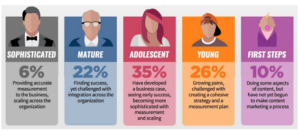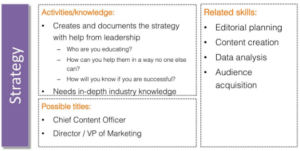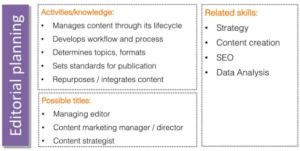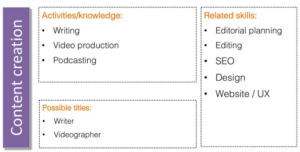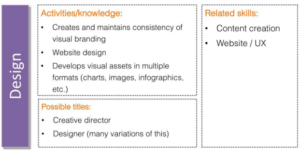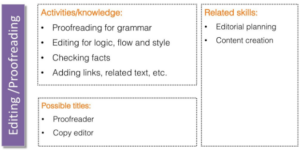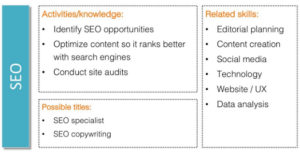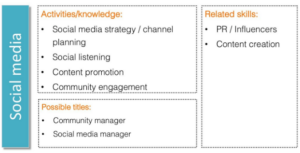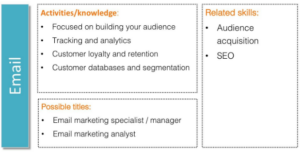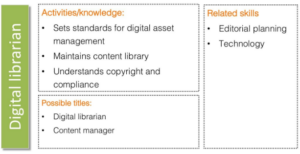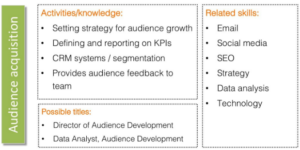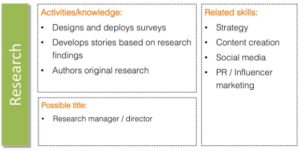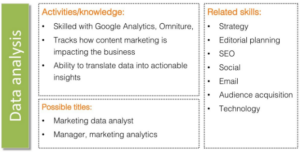One mark of a healthy content organization is that it doesn’t stop at team boundaries or silos. A healthy team understands that content is most, if not all, of the experience for our customers, and there are lots of people and teams across the company creating content for that experience. Enter: Marketing!
While there are potentially many content teams—documentation, product training, support—within an organization, especially a large one, marketing is often the most elusive for those of us traditionally seen as creators of post-sales or technical content. We know these content teams are out there, but we rarely talk with them. We know they create content, but often we don’t understand their goals or how they plan to accomplish those goals with that content.
At Content Marketing World 2017, Michele Linn, former Vice President of Editorial at the Content Marketing Institute (CMI), presented “Creating the Ultimate Content Marketing Team.” Not only was it awesome for the marketing folks in attendance, but for a post-sales content person, Michele’s content was like a peek behind a mysterious curtain. Our organizations’ marketing teams live in a world most technical communicators don’t get much exposure to, but there is tremendous value in understanding how the black box that is your marketing team—and better yet, your content marketing team—works.
Who are those people, you say, and how do I find them in my organization? What do they do? How do my activities and theirs compare, dovetail, overlap? How can or should I collaborate with them? Understanding an organization can tell you a lot about their who, where, and what.
To that end, Andrea asked Michele to collaborate on this article to help technical communicators better relate to their colleagues in marketing. As you read this, look not only toward how you might leverage this knowledge to bridge silos in your organization, but consider also how your skills might match the skills found in the ultimate content marketing team. Could content marketing be your next career?
Note that when giving shape to teams, we both shy away from using the term role or describing roles. Michele favors discussing skills, while Andrea typically refers to activities. In this article, Michele describes skill areas, and within those, activities that a person with those skills might perform within a content marketing organization. Regardless of the term you prefer, we want you to know that we are not describing roles. We provide this bit of clarification so that you, dear reader, do not infer that each of the skills described below is equivalent to a role, which might lead you to further infer that unique individuals are required to perform each role. For more discussion of how healthy organizations think about roles, see Andrea’s Editorial on page 3 of this issue.
Now that we have all of that out of the way, let’s dive in.
The Skill Areas
What skills are necessary and for what size organizations? The skills are broadly classified based on where your company falls on a spectrum of content marketing maturity, as shown in Figure 1. As CMI research reveals, about one-third of marketers are in the young and first steps categories, another third are in the adolescent stage, and the last third characterize themselves as mature or sophisticated.
Here’s how Michele sorts the skill areas based on content marketing organizational maturity. New and young companies need:
- Strategy development
- Editorial planning
- Content creation
- Design
- Editing and proofreading
A content marketing team will need to cover this first set of skills when they are starting out—or if they are struggling and not sure where to go. Every team needs to have someone who possesses these essential skills, but a team will likely not have one person per skill when getting started. Rather, it will have a leader or jack of all trades who will do many of these things. Growing companies should master:
- SEO
- Social media management
- Email management
The next three skills focus on how to get the word out about your content: social media, SEO, and email. Let’s address something we know you’re thinking: shouldn’t new and young companies have these skills on their teams, too? Absolutely. However, as Michele prioritized what skills are needed first and reflected on her experiences with building companies, she realized many companies start with someone who has a basic knowledge of each of these skills, and as they grow, they need to build in-depth team knowledge in each of these areas.
Sophisticated and mature companies should then grow their program with these skills after they have the basics covered:
- Digital library management
- Audience acquisition
- Web development and UX
- Research development
- Data analysis
- Technology management
Consider this last set of skills to be growing the content marketing program to become more sophisticated and mature. Of course, if the team has these skills, organizations should bring them in earlier in the process.
Now let’s dig into the details of each of the skill areas.
Strategy Development
It’s imperative to start out with a solid strategy (and, no, a strategy is not the same as an editorial calendar). Often, a content marketing strategy is created in conjunction with the leadership team, and it sets the stage for the entire program.
While there is no one right way to create a strategy, it should at least answer these three questions (also shown in Figure 2):
- Who are you educating?
- How can you help your audience in a way no one else can?
- How will you know if you are successful?
If you’re a technical communicator, you now know that finding your company’s chief content officer, vice president, or director of marketing could give you more insight into the strategy behind the content marketing. They could probably provide a glimpse into the overall marketing strategy as well. You might also find that they have access to market research that could be useful to you. They are a wealth of information if you can track them down.
If you have a relationship with someone in marketing already, regardless of their title, you might now have some additional options for requesting the team’s strategy. Perhaps you’ve been asking for a content strategy, and they are saying they don’t have one. But if you ask for their CCO’s strategy or plans or direction for the upcoming year, you might have more luck.
Editorial Planning
First comes strategy, then comes editorial planning.
The editorial plan is everything you need to do to bring a content marketing strategy to life. The topic of editorial planning is far bigger than one section of this article can encompass, but below are some of the key things it entails.
In many cases, multiple people on a content marketing team assist with editorial planning—people who come at it from different perspectives. For instance, someone on the team must think about all the new content to be published and answer questions, such as:
- What topics should the team cover—and how?
- What formats are best for the purposes of that content?
- What is the internal process or workflow for creating this content?
- What are the standards for publication, such as writing guidelines and style guides?
Other editorial planning professionals look at the content across the lifecycle and consider questions, such as:
- What is our organization’s taxonomy? How will the marketing content be organized?
- How will the team determine what content to keep, update, or remove?
At this point, the names of things might be starting to throw you off. In our world, editorial planning is typically a schedule for how new documentation or training is copy edited or developmentally edited. Many of the other activities, like determining what content needs to be created, are handled by folks with other titles—possibly content strategists, information architects, or team lead/project managers.
The most useful mental exercise that you can undertake at this point is to stop thinking about your content marketing team in your terms. Turn them into an audience, and start thinking about them, their goals and tasks, their deliverables, etc., in their terms.
Many content marketing professionals come from publishing and journalism. This is important to understand for lots of reasons, not just organizational ones. Now Michele’s description might be looking familiar. “Aha!” you might be thinking. “That’s where this notion of editorial planning comes from!” If you consider a magazine or newspaper, who’s really calling the day-to-day shots? The editor!
Knowing all of this, you not only decide who to contact, but you can also shape your conversations to use the right terms and speak from the right context to ensure your marketing counterpart understands what you’re saying. This is so important when so many of our terms—like editor—overlap and mean something very different.
Content Creation
When Michele chats with marketers about their teams, the biggest cry she hears is for someone to create the content: often writers, but also videographers, podcasters, etc.
While hiring an exceptional content creator is absolutely vital, great content marketing teams have a strategy and editorial plan in place first so the new talent can focus on content that will further the organization’s mission. Never start a content marketing team with the content creators.
Of course, not all writers (or any type of content creators) are created equal. Some writers excel at writing persuasive copy (à la Aristotle) that can be used in emails and on websites; some create masterful stories that dig into personalities; and others craft prescriptive, how-to content. Great content marketing team leaders figure out what the team needs and find the person who best suits those needs.
Michele expected this opinion to be an unpopular one (it likely is in marketing circles); content creators who have a deep understanding of your company’s industry are key. In this age of so much content, content marketing needs to provide the best content on the selected topics, and people who are most experienced in the subject industry are more likely to deliver the right content most efficiently and effectively.
We don’t think anyone in this crowd will find the requirement for industry knowledge to be objectionable. That’s our forté. As is how-to content, and that’s a place we understand well, which means it’s a strength we can bring to the conversation with marketing.
Design
Ah, design. Michele originally considered rolling design under content creation, but in the end, she decided to break out this skill because often the designer is a different person than a writer, podcaster, etc.
Like writers, designers often excel in different areas. Some are fabulous with website design, others rock data, and others have a penchant for e-books (just to name a few).
Many companies have designers in-house, but for content marketing teams that are just getting started, crowdsourcing design could be an option.
When it comes to design in content marketing, it’s a good idea, again, to understand where many content marketers come from: agencies, such as marketing and advertising agencies. Design in agencies is different that design in product teams. There are certainly some similarities and some overlap, but technical communicators tend to think of design as interaction design and visual design of graphical user interfaces, conceptual diagrams, and data visualizations to support technical product content. Sometimes design and user experience (UX) are used synonymously.
Andrea loves that Michele calls out that designers often excel in different areas. Don’t forget that when you are talking with your content marketing counterparts. Our designers and their designers are all part of that larger design poo—we’re just seeing different specific skill sets in product design. Also note that marketing designers are not just graphic designers creating collateral—Web design, data visualizations (hey, that sounds familiar), and other design skills have applicability to technical product content, too!
Slight tangent: All of this terminology soup makes you want to sit down and write a huge glossary of terms that spans every content practice, doesn’t it? Several have been written around different aspects of the industry, but there’s still little agreement—that’s the hard part. Those that have been written tend to come from one aspect of the field or another, with little or no input from “the other guys,” even when the authors/editors attempt to cover the entire content industry, including corporate marketing, employee communications, product content marketing, documentation, training and technical support. It’s a can of worms.
Editing and Proofreading
Another essential skill area is in proofreading. In fact, when building a new content marketing team, this is the skill that Michele would look for immediately after identifying the lead person who often focuses on strategy, editorial planning, and content creation. She learned from (painful and embarrassing) experience that you simply can’t do your own writing and editing (well, you can’t do it well). Always have that second set of eyes to check for grammatical errors.
As a content marketing practice grows, the team will benefit from not only a proofreader but also an editor (or editors). While most editors have a solid understanding of grammar and spelling, editors are also able to review a piece and tell the author whether the story is being told in a clear and compelling way or if the piece makes sense as part of a greater whole.
As with writers, it often makes sense to hire editors who have experience with the subject industry (it does not matter as much with proofreaders unless the industry is especially technical or specific). Again, a great content marketing team wants content to be best-in-class, so it’s helpful to have someone who can ask the tough questions and be knowledgeable about industry trends to ensure the content is presenting the best possible solutions.
As with content creation, this is a no-brainer skill area for technical communicators. Most know that these folks are critical to product technical content and consider them the final arbiters of quality. Most of these editors, likewise, are of the variety that Michele describes who can identify clarity and flow issues, as well as ensure a fit with the larger whole.
SEO
You might have heard that content marketing is like a 401(k) plan: your organization makes steady investments over time, and that investment grows substantially, often with only minor tweaking along the way.
Specifically, the traffic that comes from SEO is like a 401(k) plan. Email and social media are effective, but someone must constantly tend to them. While pages can always be optimized for SEO, an SEO strategy is mostly “set and forget.”
Some teams have SEO experts on staff, while others bring in consultants as needed. Mike Murray has served as CMI SEO expert for years, and he offers guidance on everything from SEO opportunities, the changing Google algorithms, the impact of mobile, and more.
In the not-too-distant past, technical communication teams often ignored SEO. With the continued trend of online content delivery, that is no longer a mindset you can afford. The likelihood that the SEO expertise in your organization is in marketing is quite high.
We recommend leveraging this expertise for yourself. Do you know what the SEO ranking is for your documentation or training? Your marketing team might!
Social Media Management
Unlike the set-and-forget of SEO, social media requires someone who is always on—and it often makes sense to have someone in-house to fulfill this role (of course, bigger companies have teams of people working on their social media).
Social media is often relegated to a junior person on the team, but this often is a big mistake—and a missed opportunity. The person who handles social media is the face of a company’s brand, and the organization must be able to implicitly trust that person (or people) to handle everything from friendly, every day interactions to delicate situations with ease and grace.
Additionally, the social media person fulfills a strategic role. This person develops the social media channel plan and understands, can communicate, and defend why the company is on each channel and why, and what its strategy is. This person must also to be able to make a case for why the organization doesn’t necessarily need to be on the newest and shiniest platform.
Lastly, this is a person who understands the implications of social media and how they interact with everything else in the content marketing strategy and editorial plan. For instance, this person should understand how social media and SEO play together.
You might be thinking, “Why would I care about social media management?” You might be surprised by how many technical communication teams have their own social media channels, and by how many lurk on their company’s channels.
Why? Direct communication with customers, that’s why! Not only can you read directly what customers are saying about your product—good, bad, and neutral—but with access to a channel, you can communicate updates, new content, and more.
If you cannot say that you have read or heard something directly from one of your customers within the past 48 hours, start systematically following your company’s social channels and get ready for some great insights!
Before you set up a channel of your own or post on your company’s Facebook page as an employee or representative of your organization, we recommend that you check around the company for a social media manager and coordinate. There are likely guidelines for who can post, what can be posted, and how you can represent yourself in relationship to the company. Best to be on the right side of that discussion.
Email Management
By distributing content through email, the content marketing team is not only sharing content, but also building an audience who wants to hear from your company.
The person on the team who is responsible for email needs to be able to:
- Help attract new subscribers
- Craft the right kinds of emails for the right moments
- Adhere to compliance regulations (such as CASL and CAN-SPAM laws)
- Address deliverability issues
- Share relevant email data with the team so they can improve loyalty and retention
- Report on email trends
If you’re thinking that email is not a distribution channel that applies to technical content, think again. As with social media, email can provide a much-needed mechanism for more direct communication with your customer. As you can with posts and tweets, you can send product content updates and news of new content via email.
As with social media, be sure that you’re aware of and following your company’s rules and guidance around communicating through email. If you are in a large company, and everyone who serves a customer starts sending her email, it could quickly overwhelm—and worse, annoy her.
Digital Library Management
Does the content marketing team have too much content that makes it difficult for team members—or the audience—to find what they need? Someone who has a digital librarian mindset helps. As Jake Athey explains:
We marketers are practically drowning in content, and librarians are experts at making content organized and findable.
Digital librarians can help solve issues surrounding all that content you have (images, blog posts, Web pages, etc.).
For instance, they can help the team avoid ROT (redundant, outdated, and trivial) content. While a company could retain all of its content, it’s a terrible practice. It overwhelms the content teams and leads to a poor experience for audience members, because they will likely stumble on content that isn’t putting the company’s best foot forward. They’ll bounce from the website with the perception that the company isn’t relevant.
Not only do digital librarians put practices in place so the content marketing team can decide what to keep and what to get rid of, but they also help organize everything so it can be easily found. They are skilled at creating taxonomies, metadata, and tagging systems.
Imagine how much time that would save—and what a better, consistent experience it would offer—if everyone on the team was working from the same version of the best content? It’s easy to see how a digital librarian can be of service in any growing company.
This is another area where technical communicators are likely ahead of the curve compared with marketing: the volume of content that we must deal with, as well as solving this problem. For example, when Andrea worked at IBM, there were hundreds of millions (yes, you read that right: hundreds of millions) of URLs in the IBM Knowledge Center that held the majority of the company’s technical product documentation.
We know that structured content, taxonomy, information architecture, content management systems, and content governance are the way to go when you’re drowning in content. It takes work to get there, but it’s worth it. And we can help the marketing team—by bringing our expertise in this area to throw them a lifeline and keep them from drowning.
Audience Acquisition
Content marketing success is contingent upon creating an audience who wants to hear from the marketer and her company—and 92 percent of the most successful content marketers focus on building an audience.
While this is a huge priority, how many marketers have someone on their team dedicated to learning about and building their audience?
As the content marketing organization grows, great teams take a cue from magazines and other media companies that are focused on subscribers (not leads)—have a person focused on truly understanding, growing, and delivering ongoing value to the team’s most precious asset: the audience.
Technical communicators typically already have an audience, but often you don’t think of them that way. Consider the people who use your documentation. They are your audience. How well do you understand them? How well are you serving them and providing value?
An additional angle on audience to ponder: marketing might not consider customers to be their main audience. Once converted, often customers are left in our hands—and the hands of technical or customer support.
Marketers, however, want advocates for the company and your products. The best way to get those advocates is to nurture them after they purchase the product, and who does that? You! This is another great angle to discuss with your marketing team. How can you partner to ensure that your customer feels a consistent sense of nurturing—a consistent content experience—from their first contact with your company and through every interaction that follows.
Web Development and UX
Content is only as effective as the experience it provides to the ideal audience. If the audience can’t easily find what it is looking for, or the experience on the company’s website is less than desirable, it’s almost a certainty that the content won’t be as effective.
In most organizations, it’s not feasible to have a dedicated person on your content marketing team who is focused on user experience and Web development. However, it’s ideal if at least one partner in the IT or Web department is available to make the website convert well and be as easy to navigate as possible.
It might not be feasible to have a dedicated Web developer or user experience designer on the content marketing team, but you likely have some access to those folks on the product development team. This is another area where you have something to potentially offer when you reach out to your content marketers.
It’s unlikely you own those resources, of course, but you can make connections and introductions across team silos, and you might be able to help the marketing team make a case for why development and UX should show them a little love.
Research Development
While much of the content marketing space is saturated, a huge opportunity, especially for B2B content marketers, exists: providing original research to their audience. In the summer of 2017, CMI conducted research with SmartBrief to learn how content influences the B2B buying process. One of the findings that resonated with Michele the most is that 74 percent of B2B buyers indicated they find original research to be influential in the buying process. B2B buyers are asking for original research from brands!
However, as the latest CMI content marketing research shows, only 37 percent of B2B marketers are using original research as one of their content marketing tactics.
Speaking from CMI experience, Michele has seen how original research on industry trends can fundamentally shape a business—and build an audience. CMI started their content marketing research in partnership with MarketingProfs in 2010, and the annual reports have become the most widely cited research in this space. To this day, CMI sees at least one new mention of their research every single day.
In short, great content marketing teams consider how they can incorporate original research into their strategy.
As a technical communicator in your company, you can never know too much. If your company has the extraordinary luxury of a researcher or research team, find them, and start bringing them chocolate and beer. (We’re only half kidding.)
Having a better fundamental understanding of your industry and its trends, including what your customers are likely doing and saying about the industry, is invaluable. It makes you a better team member who brings more value to your team. It can also give you insights that can turn your typical documentation into high-value business assets that enable wild customer success.
The more you know about your customers and their industry ecosystem, the better you can create content that is truly supporting them to meet their business and technical goals. Helping your customer to apply your product to their challenges and causing them success can turn your content from mundane to extraordinary.
Data Analysis
Far and away, the most mentioned aspirational skill in recent #CMWorld Twitter chats about teams was data analysis. Content marketers everywhere want to better understand what content is working and how they can create more of it. Or they want to understand how they can optimize existing content to do more for their brands.
If teams don’t have a good handle on data, they can partner with someone within their organization or find help. People who are data-savvy can help not only uncover needed data, and, more importantly, communicate the potential opportunities based on that data.
We suspect the technical communication side of the house is in this state as well. Having great analytics and truly understanding what content is creating customer success is the holy grail of content. If you partner with marketing, together you might have a fuller picture of how well your content is functioning.
Technology Management
The last—but certainly not least important—skill area is technology. This may be the biggest understatement in this article, but technology to support marketing has exploded in the past several years.
To get an idea of scope, consider Scott Brinker’s Marketing Technology Landscape Supergraphic (see “Resources”). The latest version, published in May 2017, includes a staggering 5,381 solutions. That’s up 40 percent from last year’s 3,500 technologies and an explosion since 150 were listed in 2011.
In short, it’s incredibly difficult to get a handle on what technology is needed when and how it will play into everything else that a team has. (We think everyone can relate to the frustrations that ensue when we don’t have the right technology in place—argh!)
Just as technical communicators have felt the pain—and found some quite workable solutions for it—in the content volume space, you are likely considerably further ahead in applying technology to your world. From content management to complex content delivery to tools and infrastructures underlying efficient processes, we have some experience here. Share!
Two Worlds Colliding
After reading all of this, you might still be saying to yourself, “This is all wrong! You have to have XYZ skills on a content team of any size!” or “Web development and UX are two totally different skill areas!” We ask you to recognize how different the maturity level of your technical content team is compared with that of your content marketing team, if you have one at all.
Conductor has a fantastic report on the Anatomy of a Content Marketing team (see “Resources”), and one of their findings is that only 20 percent of companies have an in-house digital content marketing program. And of that 20 percent, more than half are less than four years old—70.8 percent to be exact.
So while our industry has arguably been around for more than 100 years—we were forcing English composition courses on engineering students as early as the late 1800s—and your content team might have begun with employee number 19, a lone technical writer in your company’s startup days (as one of my teams did) at a time when the organization had one marketing professional, not so for content marketing. Even at 10 years, content marketing programs are still nascent compared with technical documentation programs.
All this is to say, cut your content marketing colleagues some slack, and help them out! Not only is it beneficial for you to know something about them so that you can successfully approach them with a bridge-building agenda, but you have something to offer! Review the skills that those teams need. Do they have them all? Can you collaborate with them so that the two teams become synergistic? The opportunities abound for meaningful partnerships that can serve our clients, drive revenue, build audiences, increase conversions, retain customers, and create raving fans. And isn’t that really what we all want?
By Michele Linn and Andrea L. Ames, © Intercom, Volume 65 Issue 2, March/April 2018.

